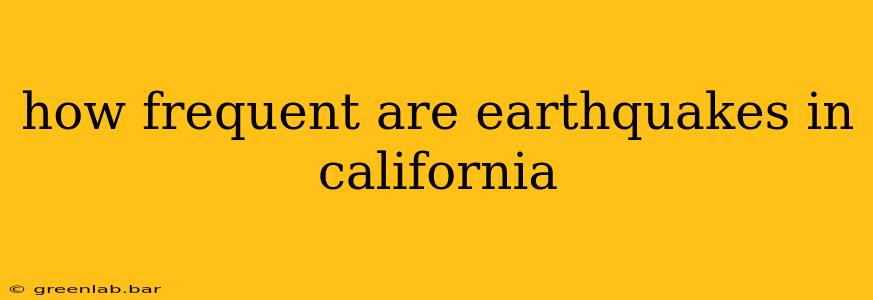California is renowned for its earthquake activity, a consequence of its location on the Pacific Ring of Fire, a highly seismic zone. But just how frequent are these tremors, and what should Californians know about the potential for future shaking? This article delves into the frequency and intensity of California earthquakes, providing valuable insights for residents and visitors alike.
Understanding California's Seismic Landscape
California's earthquake frequency is directly linked to the movement of tectonic plates. The Pacific Plate grinds against the North American Plate along the San Andreas Fault system, a complex network of faults spanning hundreds of miles. This constant friction generates stress, which is periodically released through earthquakes of varying magnitudes.
Magnitude Matters: A Spectrum of Shaking
It's crucial to understand that "earthquake frequency" encompasses a wide range of events. We're not just talking about major, headline-grabbing quakes. California experiences thousands of earthquakes every year, most of which are too small to be felt by humans. These minor tremors, often measuring less than magnitude 3.0 on the Richter scale, are constantly occurring.
-
Microquakes (Magnitude < 3.0): These are very common and usually go unnoticed. They are constantly occurring throughout the state.
-
Minor Earthquakes (Magnitude 3.0 - 4.9): These can be felt, sometimes causing minor rattling but rarely resulting in damage. These occur relatively frequently.
-
Moderate Earthquakes (Magnitude 5.0 - 6.9): These can cause damage to poorly constructed buildings and can be felt over a wider area. They are less frequent than minor quakes.
-
Major Earthquakes (Magnitude 7.0 - 7.9): These cause significant damage and destruction over large areas. They are infrequent but pose a serious threat.
-
Great Earthquakes (Magnitude 8.0+): These are extremely rare and catastrophic, causing widespread devastation. The last great earthquake in California was the 1906 San Francisco earthquake (estimated magnitude 7.9).
Earthquake Frequency Statistics
Precise figures on earthquake frequency fluctuate, but generally:
-
Thousands of earthquakes of magnitude 3.0 or less are recorded annually in California. These are often too small to detect without sensitive seismographs.
-
Hundreds of earthquakes between magnitude 3.0 and 4.0 are detected each year. Many go largely unnoticed by the public.
-
A handful of earthquakes above magnitude 5.0 occur yearly. These are the ones that draw media attention and can cause localized damage.
-
Major earthquakes (magnitude 7.0+) are much rarer, occurring perhaps every few decades or longer. The exact recurrence interval is still a subject of scientific research and debate.
Predicting the Unpredictable: The Challenges of Earthquake Forecasting
While scientists cannot predict exactly when a major earthquake will strike, they can provide probabilistic assessments based on historical data and fault line activity. This information is crucial for developing building codes, emergency preparedness plans, and public awareness campaigns. Ongoing research continues to improve our understanding of earthquake behavior and refine forecasting models.
Living with Earthquakes in California: Preparedness is Key
Given the high frequency of seismic activity, preparedness is paramount for Californians. Familiarizing oneself with earthquake safety procedures—such as "drop, cover, and hold on"—is essential. Furthermore, securing heavy objects, creating an emergency kit, and developing a family communication plan can significantly mitigate risks during and after an earthquake.
This information is for general knowledge and should not be considered a substitute for professional advice from seismologists or emergency management agencies. Consult local resources for the most up-to-date information and guidance on earthquake preparedness in your specific area.

